Breakpoint Planning Method for Rice Multibreak Milling
Abstract
:1. Introduction
2. Materials and Methods
2.1. Experimental Materials
2.2. Friction-Type Milling Process
2.3. Determination of Physical Properties
2.3.1. Size and Shape
2.3.2. Density and Weight
2.3.3. Color and Lightness
2.3.4. The coefficient of Static Friction
2.4. Statistical Analysis
2.5. Generalized Regression Neural Network (GRNN)
3. Result and Discussion
3.1. Change in Physical Properties during Milling
3.2. The Breakpoint Planning Method
3.3. Grading Strategy
Hierarchical Cluster Analysis
3.4. Breakpoint Planning
3.4.1. Setting up a Multibreak Milling System with n Breakpoints
3.4.2. Redistribution of Milled Rice
Properties Reduction
Assessment Model
Effectiveness of Planning Method
4. Conclusions
Author Contributions
Funding
Data Availability Statement
Conflicts of Interest
References
- Zeng, Y.; Jia, F.; Meng, X.; Han, Y.; Xiao, Y. The effects of friction characteristic of particle on milling process in a horizontal rice mill. Adv. Powder Technol. 2018, 29, 1280–1291. [Google Scholar] [CrossRef]
- Chen, Q.; Li, P.; Li, Z.; Corke, H.; Sui, Z. Combined speed and duration of milling affect the physicochemical properties of rice flour. Food Hydrocoll. 2019, 89, 188–195. [Google Scholar]
- Zeng, Y.; Jia, F.; Chen, P.; Qiu, H.; Han, Y.; Meng, X.; Xiao, Y. Effects of convex rib height on spherical particle milling in a lab-scale horizontal rice mill. Powder Technol. 2018, 342, 1–10. [Google Scholar] [CrossRef]
- Meng, X.; Jia, F.; Xiao, Y.; Han, Y.; Zeng, Y.; Li, A. Effect of operating parameters on milling quality and energy consumption of brown rice. J. Food Sci. Technol. 2018, 56, 674–682. [Google Scholar] [CrossRef] [PubMed]
- Kate, A.; Lohani, U.; Shahi, N.; Pandey, J.; Chand, K. Effects of moisture content and feed rate on milling characteristics of wild apricot pits (Prunus armeniaca L.). Int. J. Agric. Biol. Eng. 2014, 103, 103–110. [Google Scholar]
- Fu, J.; Xue, Z.; Chen, Z.; Ren, L. Experimental study on specific grinding energy and particle size distribution of maize grain, stover and cob. Int. J. Agric. Biol. Eng. 2020, 13, 135–142. [Google Scholar] [CrossRef]
- Lamberts, L.; De Bie, E.; Vandeputte, G.; Veraverbeke, W.; Derycke, V.; De Man, W.; Delcour, J. Effect of milling on colour and nutritional properties of rice. Food Chem. 2007, 99, 1496–1503. [Google Scholar] [CrossRef]
- Li, Y.; Li, K.; Ding, W.; Chen, K.; Ding, Q. Correlation between head rice yield and specific mechanical property differences between dorsal side and ventral side of rice kernels. J. Food Eng. 2014, 123, 60–66. [Google Scholar] [CrossRef]
- Liu, K.; Zheng, J.; Chen, F. Relationships between degree of milling and loss of Vitamin B, minerals, and change in amino acid composition of brown rice. LWT Food Sci. Technol. 2017, 82, 429–436. [Google Scholar] [CrossRef]
- Chen, H.; Siebenmorgen, T.; Griffin, K. Quality Characteristics of Long-Grain Rice Milled in Two Commercial Systems. Cereal Chem. 1998, 75, 560–565. [Google Scholar] [CrossRef]
- Graves, A.; Siebenmorgen, T.; Saleh, M. A Comparative Study Between the McGill #2 Laboratory Mill and Commercial Milling Systems. Cereal Chem. 2009, 86, 907291303–907291476. [Google Scholar]
- Zareiforoush, H.; Minaei, S.; Alizadeh, M.; Banakar, A. A hybrid intelligent approach based on computer vision and fuzzy logic for quality measurement of milled rice. Measurement 2015, 66, 26–34. [Google Scholar] [CrossRef]
- Wood, D.; Siebenmorgen, T.; Williams, T.; Orts, W.; Glenn, G. Use of microscopy to assess bran removal patterns in milled rice. J. Agric. Food Chem. 2012, 60, 6960. [Google Scholar] [CrossRef]
- Zhu, S.; Hu, F.; Ramaswamy, H.; Yu, Y.; Yu, L.; Zhang, Q. Effect of High Pressure Treatment and Degree of Milling on Gelatinization and Structural Properties of Brown Rice. Food Bioprocess Technol. 2016, 9, 1–10. [Google Scholar] [CrossRef]
- Mohapatra, D.; Bal, S. Physical Properties of Indica Rice in Relation to Some Novel Mechanical Properties Indicating Grain Characteristics. Food Bioprocess Technol. 2012, 5, 2111–2119. [Google Scholar] [CrossRef]
- Meghwal, M.; Goswami, T. Comparative study on ambient and cryogenic grinding of fenugreek and black pepper seeds using rotor, ball, hammer and Pin mill. Powder Technol. 2014, 267, 245–255. [Google Scholar] [CrossRef]
- Chimwani, N.; Mulenga, F.; Hildebrandt, D. Ball size distribution for the maximum production of a narrowly-sized mill product. Powder Technol. 2015, 284, 12–18. [Google Scholar] [CrossRef]
- Bhat, F.; Riar, C. Cultivars effect on the physical characteristics of rice (rough and milled) (Oryza Sativa L.) of temperate region of Kashmir (India). J. Food Sci. Technol. 2016, 53, 4258. [Google Scholar] [CrossRef]
- Yadav, B.; Jindal, V. Changes in head rice yield and whiteness during milling of rough rice (Oryza sativa L.). J. Food Eng. 2008, 86, 113–121. [Google Scholar] [CrossRef]
- Sharma, P.; Chakkaravarthi, A.; Singh, V.; Subramanian, R. Grinding characteristics and batter quality of rice in different wet grinding systems. J. Food Eng. 2008, 88, 499–506. [Google Scholar] [CrossRef]
- Monks, J.; Vanier, N.; Casaril, J.; Berto, R.; De Oliveira, M.; Gomes, C.; De Carvalho, M.; Dias, A.; Elias, M. Effects of milling on proximate composition, folic acid, fatty acids and technological properties of rice. J. Food Compos. Anal. 2013, 30, 73–79. [Google Scholar] [CrossRef]
- Kara, D. Evaluation of trace metal concentrations in some herbs and herbal teas by principal component analysis. Food Chem. 2009, 114, 347–354. [Google Scholar] [CrossRef]
- Keenan, D.F.; Valverde, J.; Gormley, R.; Butler, F.; Brunton, N.P. Selecting apple cultivars for use in ready-to-eat desserts based on multivariate analyses of physico-chemical properties. LWT Food Sci. Technol. 2012, 48, 308–315. [Google Scholar] [CrossRef]
- Cebi, N.; Yilmaz, M.; Sagdic, O. A rapid ATR-FTIR spectroscopic method for detection of sibutramine adulteration in tea and coffee based on hierarchical cluster and principal component analyses. Food Chem. 2017, 229, 517–526. [Google Scholar] [CrossRef]
- Barua, S.; Khuntia, A.; Srivastav, P.P.; Vilgis, T.A. Understanding the native and hydrothermally modified elephant foot yam (amorphophallus paeoniifolius) starch system: A multivariate approach. LWT Food Sci. Technol. 2021, 150, 111958. [Google Scholar] [CrossRef]
- de Barros, H.E.A.; Alexandre, A.C.S.; Campolina, G.A.; Alvarenga, G.F.; Natarelli, C.V.L.; Carvalho, E.E.N.; Boas, E.V.D.B.V. Edible seeds clustering based on phenolics and antioxidant activity using multivariate analysis. LWT Food Sci. Technol. 2021, 152, 112372. [Google Scholar] [CrossRef]
- Yang, M.; Zhai, X.; Huang, X.; Li, Z.; Shi, J.; Li, Q.; Battino, M. Rapid discrimination of beer based on quantitative aroma determination using colorimetric sensor array. Food Chem. 2021, 363, 130297. [Google Scholar] [CrossRef]
- Sharin, S.N.; Sani, M.S.A.; Jaafar, M.A.; Yuswan, M.H.; Kassim, N.K.; Manaf, Y.N.; Hashim, A.M. Discrimination of Malaysian stingless bee honey from different entomological origins based on physicochemical properties and volatile compound profiles using chemometrics and machine learning. Food Chem. 2021, 346, 128654. [Google Scholar] [CrossRef]
- Patras, A.; Brunton, N.; Downey, G.; Rawson, A.; Warriner, K.; Gernigon, G. Application of principal component and HCA to classify fruits and vegetables commonly consumed in Ireland based on in vitro antioxidant activity. J. Food Compos. Anal. 2011, 24, 250–256. [Google Scholar] [CrossRef]
- Romani, S.; Cevoli, C.; Fabbri, A.; Alessandrini, L.; Rosa, M. Evaluation of Coffee Roasting Degree by Using Electronic Nose and Artificial Neural Network for Off-line Quality Control. J. Food Sci. 2012, 77, C960–C965. [Google Scholar] [CrossRef]
- Guo, W.; Shang, L.; Zhu, X.; Nelson, S. Nondestructive Detection of Soluble Solids Content of Apples from Dielectric Spectra with ANN and Chemometric Methods. Food Bioprocess Technol. 2015, 8, 1126–1138. [Google Scholar] [CrossRef]
- GB 5009.3-2016; Determination of Moisture in Food. Standards Press of China: Beijing, China, 2016.
- Heidarbeigi, K.; Ahmadi, H.; Kheiralipour, K.; Tabatabaeefar, A. Some physical and mechanical properties of khinjuk. Pakistan J. Nutr. 2009, 8, 74–77. [Google Scholar] [CrossRef]
- Mohsenin, N.N. Physical Properties of Plant and Animal Materials, 2nd ed.; Gordon and Breach Science Publishers: New York, NY, USA, 1986. [Google Scholar]
- Irtwange, S.V. The Effect of Accession on Some Physical and Engineering Properties of African Yam Bean. Ph.D. Thesis, Department of Agricultural Engineering, University of Ibadan, , Ibadan, Nigeria, 2000. [Google Scholar]
- Roy, P.; Ijiri, T.; Okadome, H.; Nei, D.; Orikasa, T.; Nakamura, N.; Shiina, T. Effect of processing conditions on overall energy consumption and quality of rice (Oryza sativa L.). J. Food Eng. 2008, 89, 343–348. [Google Scholar] [CrossRef]
- Specht, D.F. A general regression neural network. IEEE Trans. Neural Netw. 1991, 2, 568–576. [Google Scholar] [CrossRef]
- Liu, K.; Cao, X.; Bai, Q.; Wen, H.; Gu, Z. Relationships between physical properties of brown rice and degree of milling and loss of selenium. J. Food Eng. 2009, 94, 69–74. [Google Scholar] [CrossRef]
- Buggenhout, J.; Brijs, K.; Celus, I.; Delcour, J. The breakage susceptibility of raw and parboiled rice: A review. J. Food Eng. 2013, 117, 304–315. [Google Scholar] [CrossRef]
- Han, Y.; Jia, F.; Zeng, Y.; Jiang, L.; Zhang, Y.; Cao, B. DEM study of particle conveying in a feed screw section of vertical rice mill. Powder Technol. 2017, 311, 213–225. [Google Scholar] [CrossRef]
- Corrêa, P.C.; Silva, F.S.D.; Jaren, C.; Júnior, P.C.A.; Arana, I. Physical and mechanical properties in rice processing. J. Food Eng. 2007, 79, 137–142. [Google Scholar] [CrossRef]
- Hussain, M.; Ahmed, S.; Abderrahman, W. Cluster analysis and quality assessment of logged water at an irrigation project, eastern Saudi Arabia. J. Environ. Manag. 2008, 86, 297–307. [Google Scholar] [CrossRef]
- Bendu, H.; Deepak, B.; Murugan, S. Application of GRNN for the prediction of performance and exhaust emissions in HCCI engine using ethanol. Energy Convers. Manag. 2016, 122, 165–173. [Google Scholar] [CrossRef]
- Rooki, R. Application of general regression neural network (GRNN) for indirect measuring pressure loss of Herschel–Bulkley drilling fluids in oil drilling. Measurement 2016, 85, 184–191. [Google Scholar] [CrossRef]
- GB 18105-2000; Method for Determination of the Processing Degree of Rice and Other Grain Kernels Using Iso-Color-Phase Differenrial Staining (IDS). Standards Press of China: Beijing, China, 2000.
- GB 1354-2009; Rice. Standards Press of China: Beijing, China, 2009.
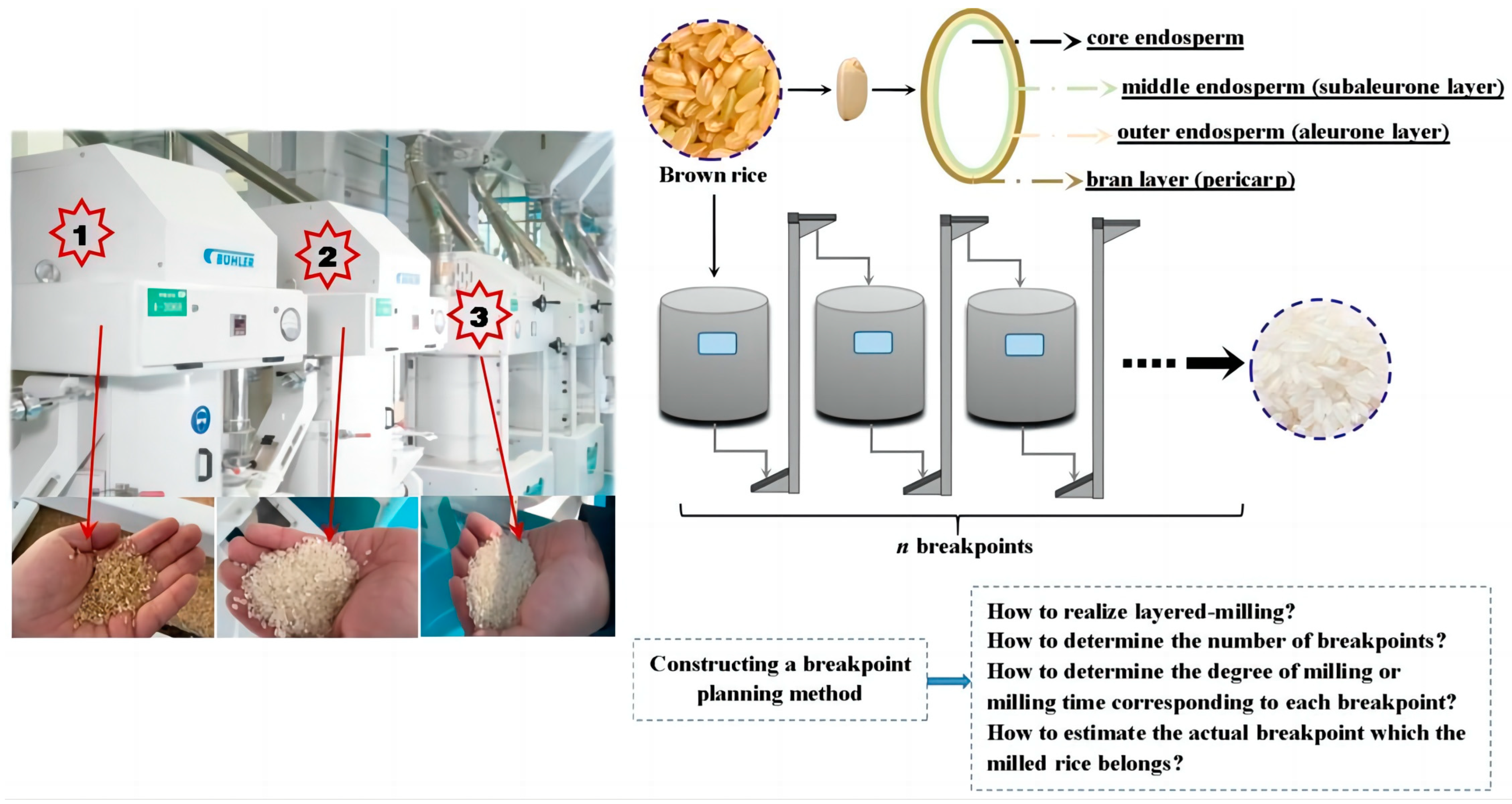
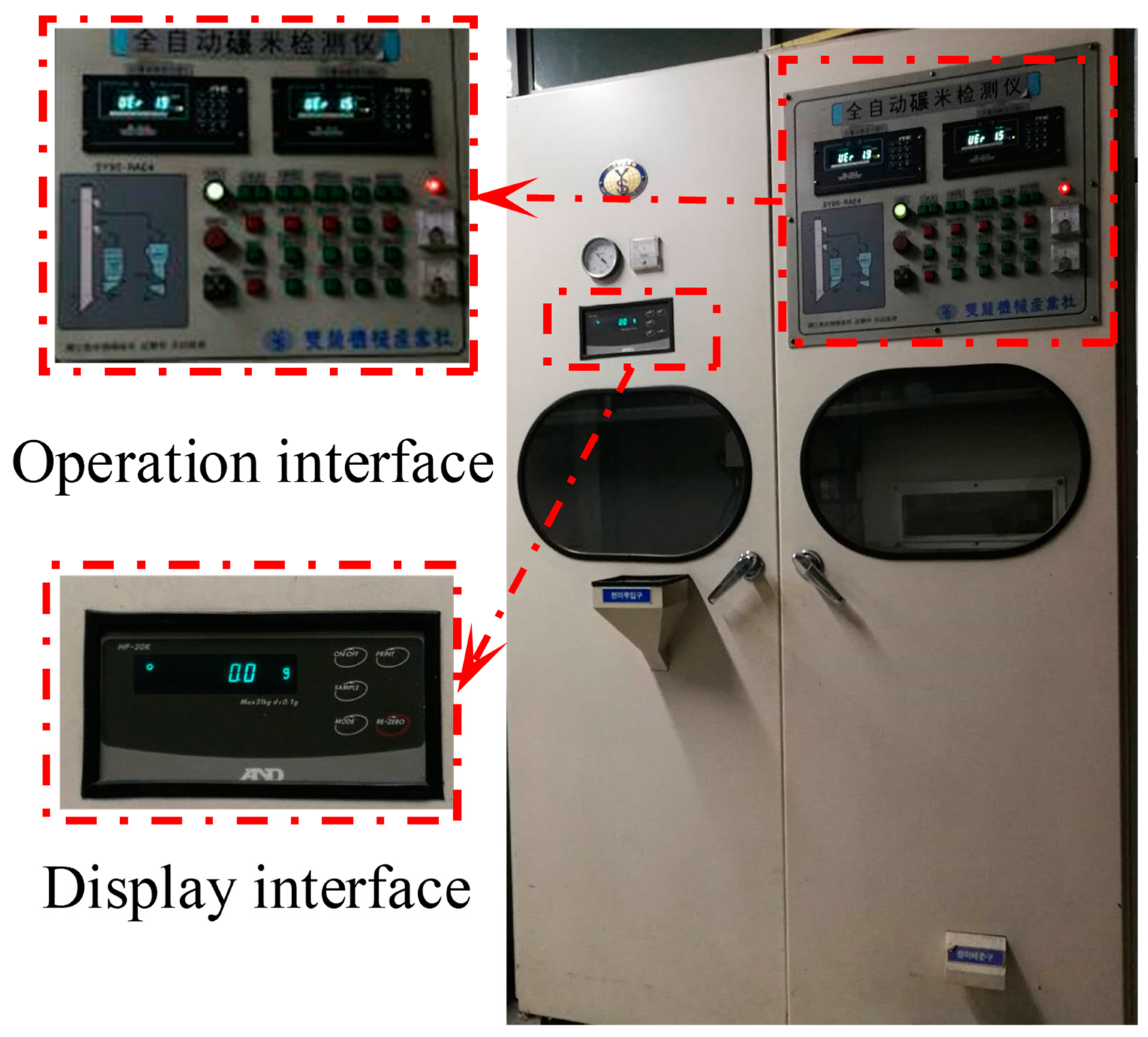
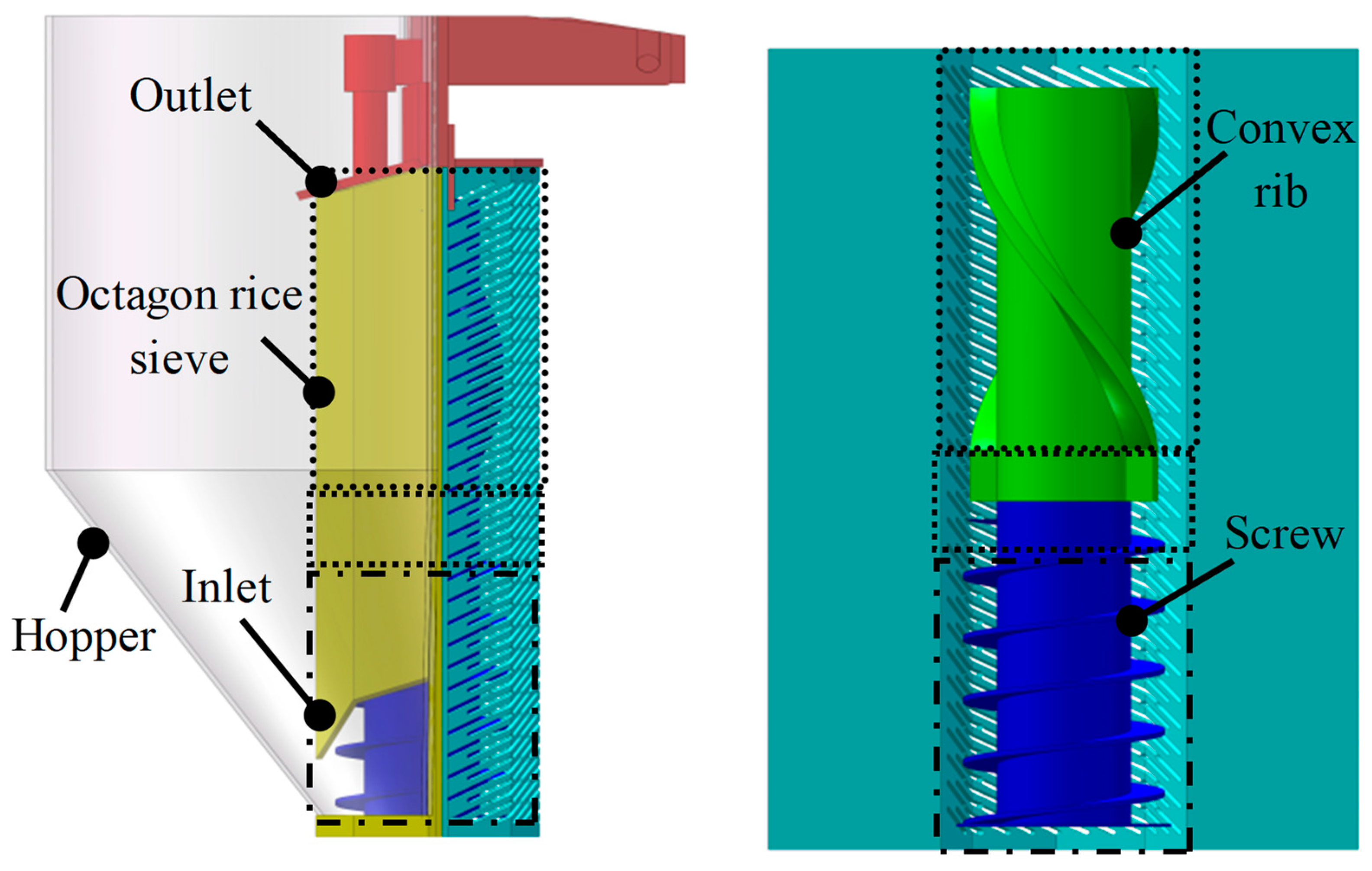


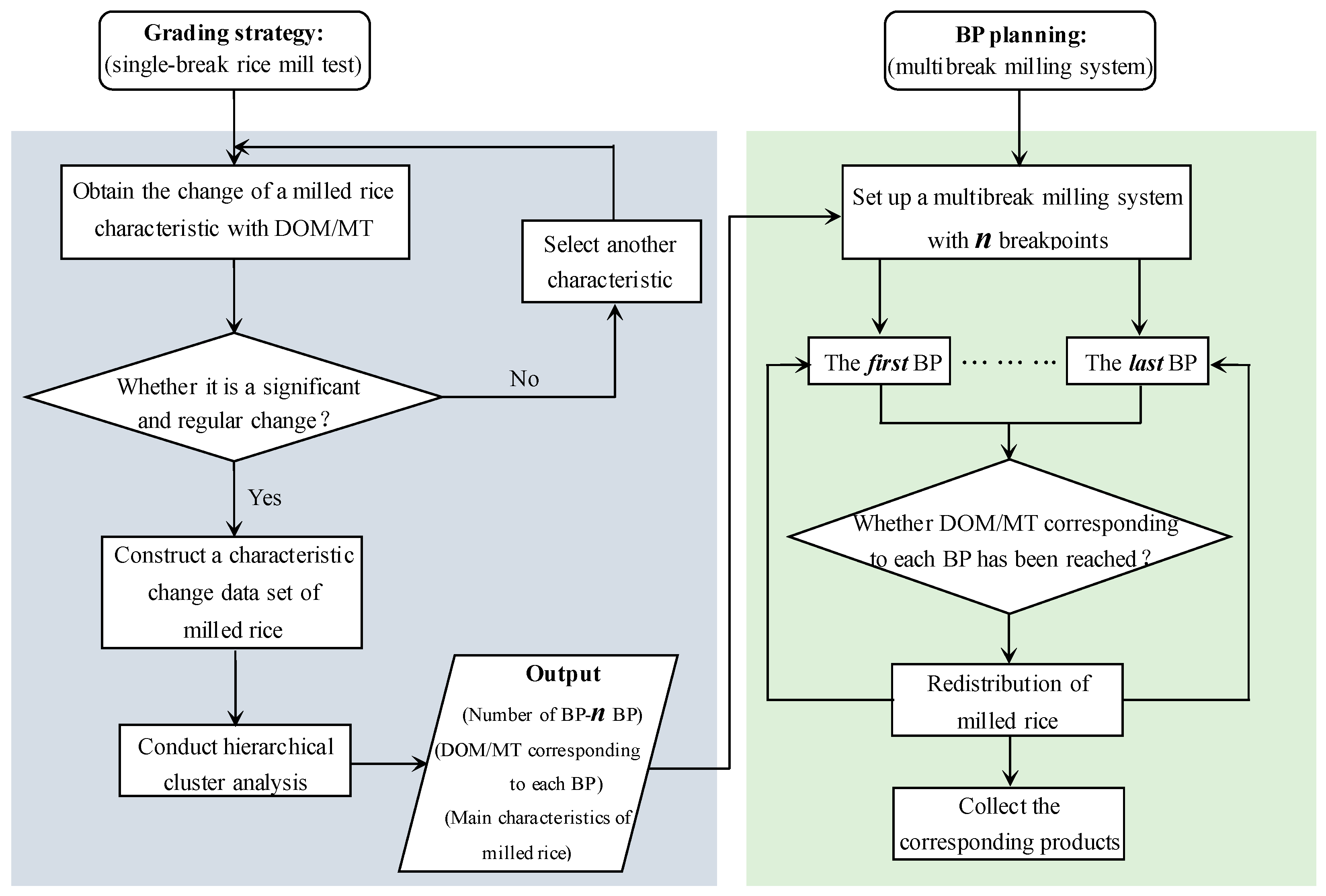

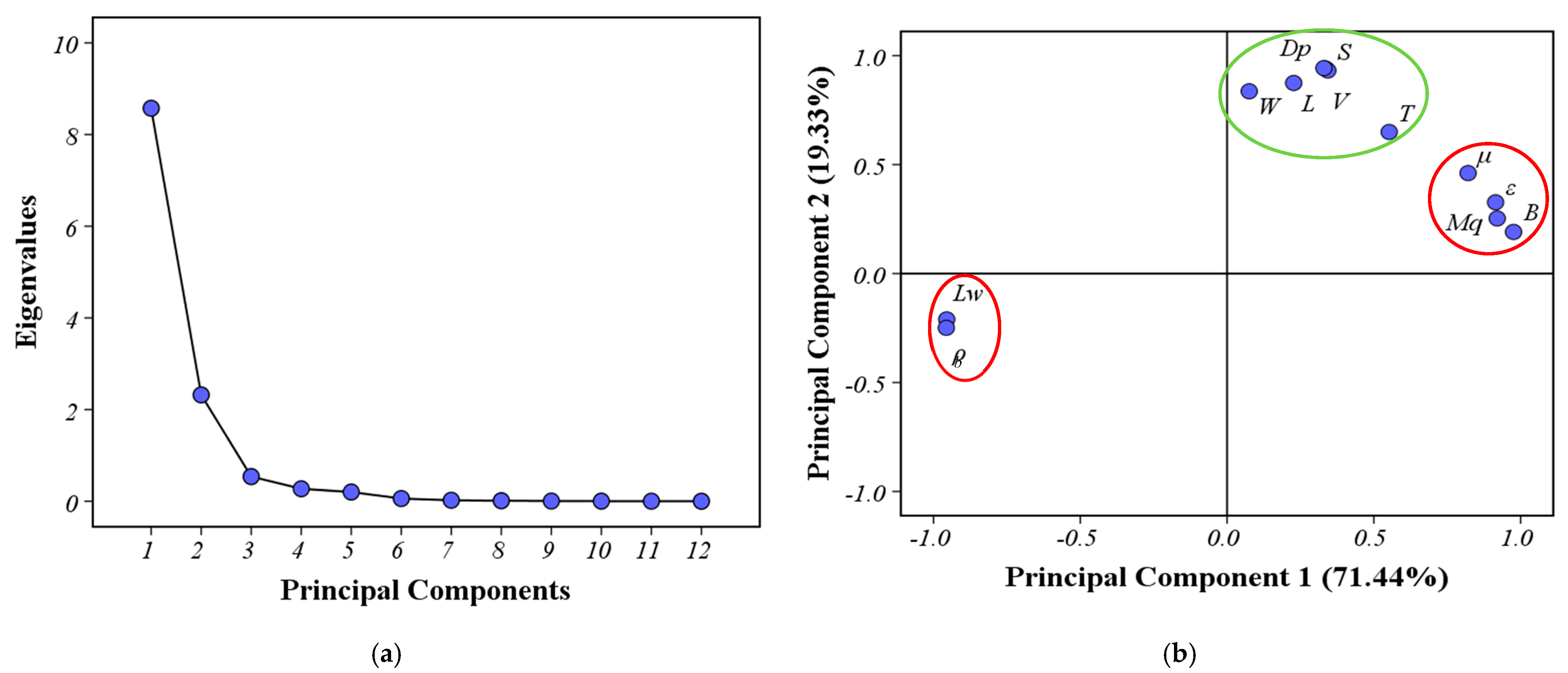
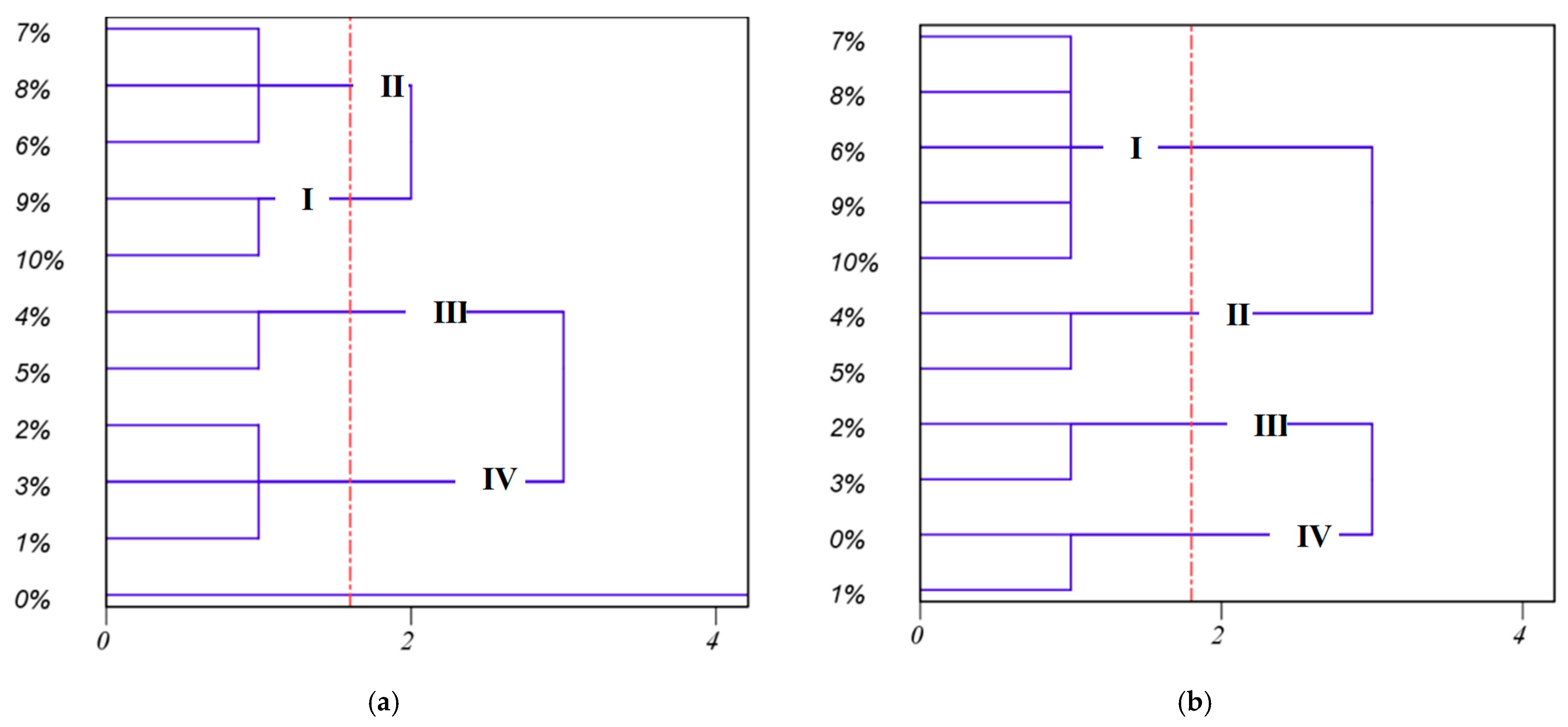
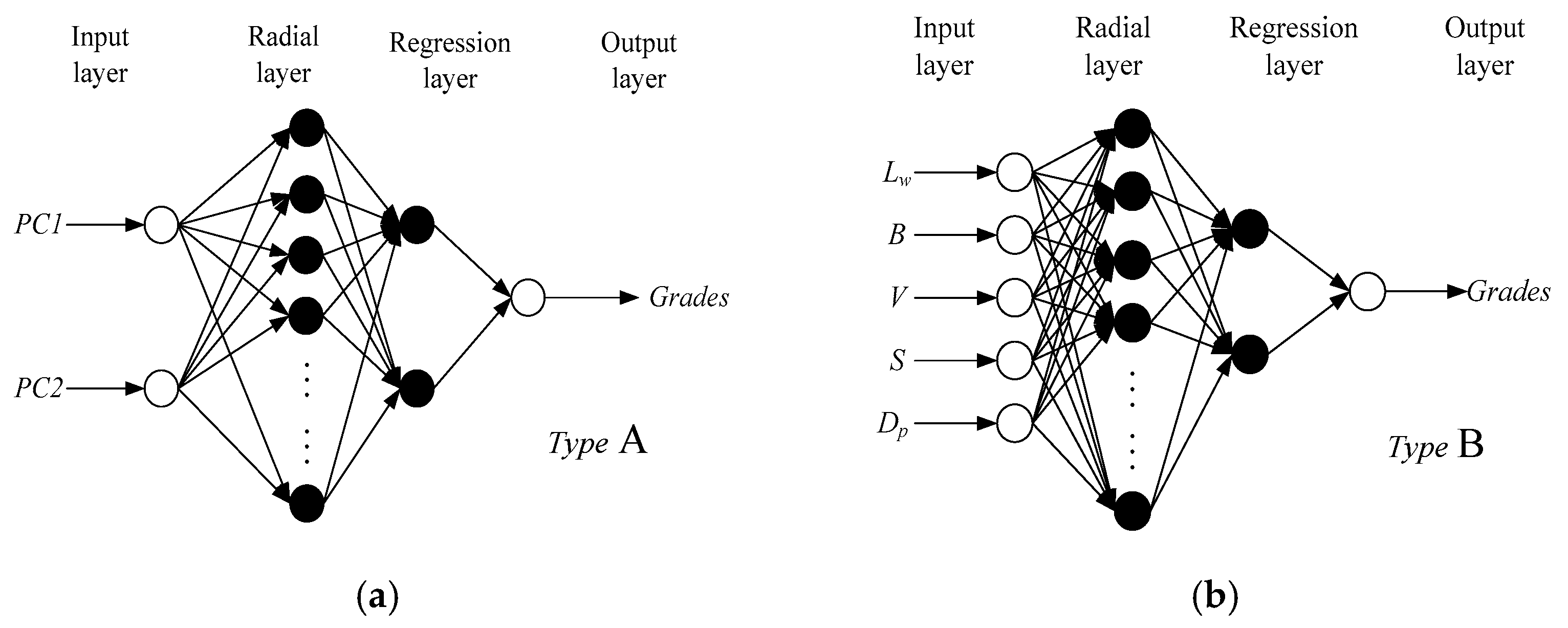
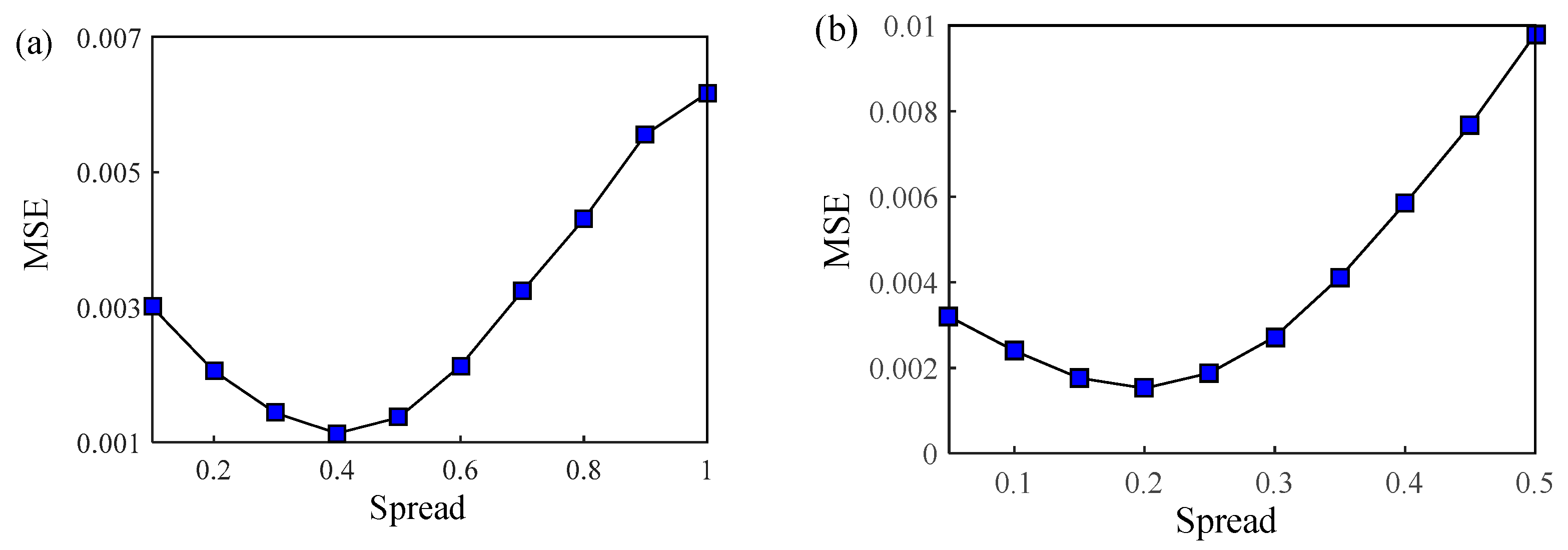
| Physical Property | N | Brown Rice | Degree of Milling | |||||||||
|---|---|---|---|---|---|---|---|---|---|---|---|---|
| 1% | 2% | 3% | 4% | 5% | 6% | 7% | 8% | 9% | 10% | |||
| Length (mm) ** | 100 | 5.932 a | 5.710 b | 5.708 b | 5.680 bc | 5.590 bcd | 5.700 b | 5.629 bcd | 5.509 d | 5.616 bcd | 5.552 cd | 5.542 d |
| (0.381) | (0.227) | (0.267) | (0.272) | (0.276) | (0.330) | (0.285) | (0.249) | (0.290) | (0.262) | (0.230) | ||
| Width (mm) ** | 100 | 2.398 a | 2.393 a | 2.392 a | 2.346 ab | 2.316 abc | 2.302 bcd | 2.286 bcde | 2.305 bcd | 2.257 cde | 2.229 de | 2.215 e |
| (0.394) | (0.119) | (0.122) | (0.123) | (0.108) | (0.131) | (0.130) | (0.323) | (0.109) | (0.102) | (0.100) | ||
| Thickness (mm) ** | 100 | 1.754 a | 1.692 ab | 1.670 b | 1.651 b | 1.640 bc | 1.584 cd | 1.568 abc | 1.533 de | 1.528 de | 1.527 de | 1.506 e |
| (0.075) | (0.413) | (0.076) | (0.087) | (0.077) | (0.082) | (0.084) | (0.088) | (0.069) | (0.082) | (0.070) | ||
| Aspect ratio ** | 100 | 2.509 b | 2.386 d | 2.386 d | 2.421 abcd | 2.414 acd | 2.476 abd | 2.463 abcd | 2.390 cd | 2.488 abd | 2.491 ab | 2.502 b |
| (0.291) | (0.134) | (0.140) | (0.160) | (0.168) | (0.195) | (0.175) | (0.190) | (0.186) | (0.170) | (0.160) | ||
| Volume (mm3) ** | 100 | 13.47 a | 12.47 ab | 12.32 bc | 11.87 bcd | 11.44 cde | 11.26 de | 10.94 def | 10.62 ef | 10.53 ef | 10.25 f | 10.04 f |
| (3.68) | (4.34) | (1.28) | (1.17) | (0.94) | (1.18) | (1.27) | (2.92) | (0.99) | (0.85) | (0.80) | ||
| Surface area (mm2) ** | 100 | 23.01 a | 21.89 b | 21.72 b | 21.22 bc | 20.70 cd | 20.52 cd | 20.12 de | 19.60 ef | 19.62 ef | 19.28 f | 19.02 f |
| (2.66) | (3.48) | (1.49) | (1.37) | (1.13) | (1.45) | (1.52) | (2.08) | (1.26) | (1.09) | (1.03) | ||
| Equivalent diameter (mm) ** | 100 | 2.94 a | 2.88 b | 2.87 b | 2.83 bc | 2.80 cd | 2.78 cde | 2.75 def | 2.73 efg | 2.72 fg | 2.70 g | 2.68 g |
| (0.20) | (0.21) | (0.10) | (0.09) | (0.08) | (0.1) | (0.11) | (0.17) | (0.08) | (0.07) | (0.07) | ||
| Sphericity ** | 100 | 0.492 ab | 0.499 a | 0.497 a | 0.493 a | 0.495 a | 0.482 bcd | 0.484 bcd | 0.488 abc | 0.478 cd | 0.480 cd | 0.477 d |
| (0.029) | (0.029) | (0.017) | (0.019) | (0.019) | (0.022) | (0.019) | (0.021) | (0.017) | (0.018) | (0.017) | ||
| Bulk density (kg/m3) ** | 5 | 761.27 | 779.10 | 783.69 | 784.25 | 810.16 | 812.28 | 814.35 | 819.52 | 822.39 | 822.47 | 824.45 |
| (1.96) f | (0.92) e | (2.97) de | (3.99) d | (2.05) c | (0.06) c | (1.07) bc | (2.75) ab | (0.25) a | (1.20) a | (0.28) a | ||
| True density (kg/m 3) NS | 5 | 1333.33 | 1333.34 | 1333.31 | 1333.33 | 1333.34 | 1333.30 | 1333.56 | 1333.21 | 1333.67 | 1333.32 | 1333.32 |
| (0.01) a | (0.01) a | (0.00) a | (0.02) a | (0.00) a | (0.00) a | (0.01) a | (0.05) a | (0.00) a | (0.00) a | (0.00) a | ||
| Porosity (%) ** | 5 | 42.90 a | 41.57 b | 41.22 bc | 40.18 c | 39.24 d | 39.08 d | 38.92 de | 38.54 ef | 38.32 f | 38.31 f | 38.17 f |
| (0.15) | (0.07) | (0.22) | (0.30) | (0.15) | (0.00) | (0.08) | (0.21) | (0.02) | (0.09) | (0.02) | ||
| Static friction coefficient ** | 5 | 0.30 a | 0.29 a | 0.27 a | 0.27 a | 0.27 a | 0.26 a | 0.18 b | 0.18 b | 0.17 b | 0.16 b | 0.15 b |
| (0.01) | (0.01) | (0.01) | (0.00) | (0.01) | (0.02) | (0.04) | (0.00) | (0.02) | (0.00) | (0.01) | ||
| Thousand seed weight (g) ** | 5 | 21.01 a | 20.98 a | 20.30 b | 20.03 c | 19.94 c | 19.53 d | 19.14 e | 19.26 ef | 19.00 f | 18.40 g | 18.25 g |
| (0.07) | (0.05) | (0.03) | (0.03) | (0.01) | (0.09) | (0.04) | (0.06) | (0.08) | (0.13) | (0.02) | ||
| Whiteness (Lw) ** | 5 | 46.25 h | 47.90 g | 49.54 f | 50.11 ef | 51.15 de | 51.75 d | 52.93 c | 53.66 bc | 53.91 bc | 54.33 b | 55.86 a |
| (0.16) | (0.32) | (0.27) | (0.55) | (0.60) | (0.42) | (0.05) | (0.37) | (0.69) | (0.25) | (0.17) | ||
| Chromaticity (B) ** | 5 | 22.57 a | 19.84 b | 18.33 c | 17.76 c | 16.52 d | 15.92 d | 14.81 e | 14.13 ef | 13.47 fg | 13.00 g | 12.45 g |
| (0.41) | (0.41) | (0.24) | (0.64) | (0.33) | (0.25) | (0.13) | (0.42) | (0.14) | (0.32) | (0.40) | ||
| Time (s) | 0 | 4 | 7 | 8 | 12 | 18 | 25 | 42 | 89 | 155 | 196 | |
| Physical Properties | Eigenvectors | The Rotated Loadings | ||
|---|---|---|---|---|
| PC1 | PC2 | PC1 | PC2 | |
| Length (mm) | 0.26 | 0.33 | 0.227 | 0.874 |
| Width (mm) | 0.21 | 0.38 | 0.075 | 0.837 |
| Thickness (mm) | 0.29 | 0.08 | 0.552 | 0.649 |
| Volume (mm3) | 0.30 | 0.32 | 0.336 | 0.940 |
| Surface area (mm2) | 0.30 | 0.31 | 0.343 | 0.932 |
| Equivalent diameter (mm) | 0.30 | 0.32 | 0.330 | 0.943 |
| Bulk density (kg/m3) | −0.29 | 0.31 | −0.955 | −0.210 |
| Porosity (%) | 0.29 | −0.28 | 0.920 | 0.253 |
| Static friction coefficient | 0.31 | −0.13 | 0.821 | 0.461 |
| Thousand seed weight (g) | 0.31 | −0.24 | 0.915 | 0.327 |
| Whiteness (Lw) | −0.30 | 0.29 | −0.957 | −0.249 |
| Chromaticity (B) | 0.29 | −0.33 | 0.976 | 0.191 |
| DOM | Number of Samples | Results of Assessment | Total Number of Each Grades | The Results Obtained by the Standard Method | Correct Rate | |||||
|---|---|---|---|---|---|---|---|---|---|---|
| 3% | 40 | I | II | III | IV | I (3%,5%,8%,10%) | 44 | I (3%,5%,8%,10%) | 44 | 100% |
| 0 | 6 | 10 | 24 | |||||||
| 5% | 40 | I | II | III | IV | II (3%,5%,8%,10%) | 60 | II (3%,5%,8%,10%) | 57 | 92.86% |
| 3 | 19 | 18 | 0 | |||||||
| 8% | 40 | I | II | III | IV | III (3%,5%,8%,10%) | 32 | III (3%,5%,8%,10%) | 34 | 88.24% |
| 10 | 29 | 1 | 0 | |||||||
| 10% | 40 | I | II | III | IV | IV (3%,5%,8%,10%) | 24 | IV (3%,5%,8%,10%) | 25 | 96% |
| 31 | 6 | 3 | 0 | |||||||
| Total/average | 160 | 44 | 60 | 32 | 24 | 160 | 160 | 94.28% | ||
Disclaimer/Publisher’s Note: The statements, opinions and data contained in all publications are solely those of the individual author(s) and contributor(s) and not of MDPI and/or the editor(s). MDPI and/or the editor(s) disclaim responsibility for any injury to people or property resulting from any ideas, methods, instructions or products referred to in the content. |
© 2023 by the authors. Licensee MDPI, Basel, Switzerland. This article is an open access article distributed under the terms and conditions of the Creative Commons Attribution (CC BY) license (https://creativecommons.org/licenses/by/4.0/).
Share and Cite
Xiao, Y.; Jia, F.; Meng, X.; Han, Y. Breakpoint Planning Method for Rice Multibreak Milling. Foods 2023, 12, 1864. https://doi.org/10.3390/foods12091864
Xiao Y, Jia F, Meng X, Han Y. Breakpoint Planning Method for Rice Multibreak Milling. Foods. 2023; 12(9):1864. https://doi.org/10.3390/foods12091864
Chicago/Turabian StyleXiao, Yawen, Fuguo Jia, Xiangyi Meng, and Yanlong Han. 2023. "Breakpoint Planning Method for Rice Multibreak Milling" Foods 12, no. 9: 1864. https://doi.org/10.3390/foods12091864






